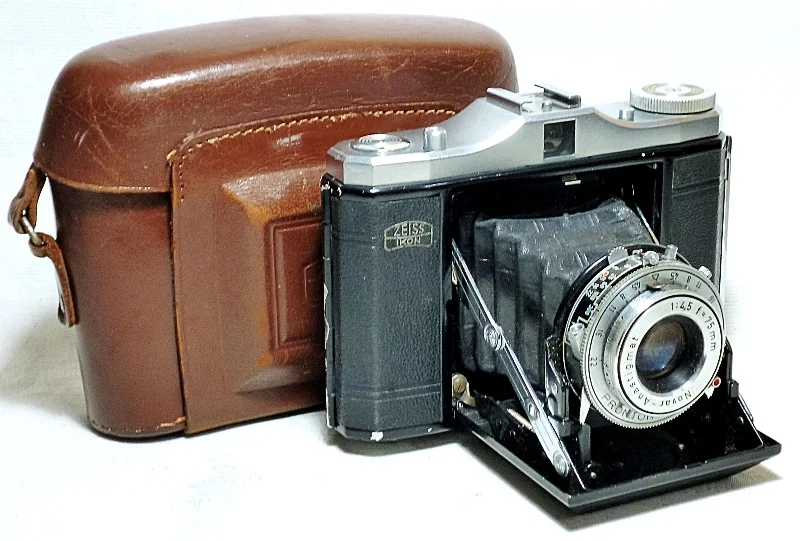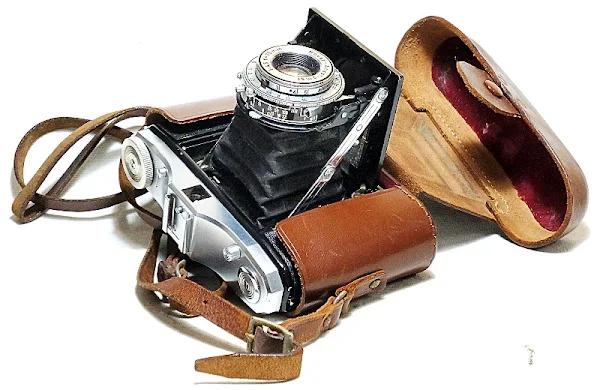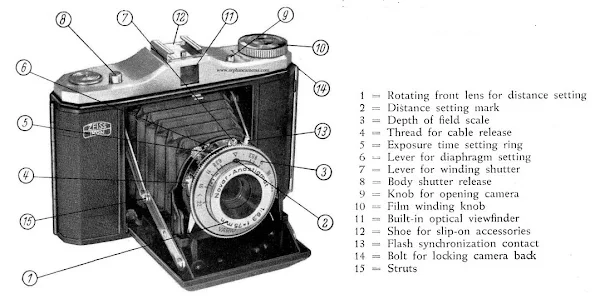These cameras were targeted at the amateur market, and the model range was an infusion of several 6x4.5, 6x6, and 6x9 medium format camera models fitted (based on the year of production) with a wide range of lenses with differing focal lengths, with equally different shutter combinations.
Production of the vertical folders started with the Nettar 510 (1934), and Nettar 518/2 (1952 to 1958), while the horizontal folders started with the Netter 515/16 (1937), 516/16 (1940), and later the Nettar II's, which includes the 517/16 (1951 to 1957), and 518/16 (1949 to 1957). Among this lot is the one-off Nettax 513/16, which came with an exposure meter.
The range of lens and shutter combinations for the Nettars includes (as seen on Camera Wiki) the following:
- Nettar 1:6.3/7.5cm, Derval or Telma leaf shutter for Nettar 510,
- Nettar 1:7.7/10.5cm, Gauthier leaf shutter, speeds 1/25 sec – 1/75 sec for Nettar 510/2,
- Nettar 1:6.3/7.5cm, Derval or Telma leaf shutter, or Nettar 1:4.5/7.5cm, Telma or Klio leaf shutter for Nettar 515,
- Novar Anastigmat 1:6.3/10.5cm, Vario leaf shutter, or Novar Anastigmat 1:4.5/10.5cm, Pronto or Prontor-S leaf shutter for the post-war Nettar 515/2.
The Nettar II 518/16
The review unit, likely the 6x6 Nettar II 518/16, is the earlier version of the two produced from 1951 to 1957. The camera carries the Zeiss Ikon logo on the front (left of the door) and the name 'Nettar' on the front door, a direct vision optical viewfinder below the flash shoe, a gradual curved top plate, coated Novar Anastigmat 1:4.5/75mm lens, Pronto leaf shutter with a speed range from 1 to 1/300 second, and B with an aperture dial set from 6.3 to 22.
Based on the listing on Camera Wiki, the Nettar 518/16 is also a mixed range of models and comes fitted with either a Novar Anastigmat 1:4.5/75mm, or a 1:6.3/75mm lens and either a Pronto, Vario, Prontor-S, or Prontor-SV shutter.
Though looking winded with the leatherette showing its age, the review unit was still in an overall excellent condition, with the bellows looking good and light tight, the spring loads strong, and the shutter mechanism working in perfect order, sharp and crisp, a testament to the strength and quality of these German-built post-war mechanical contraptions. The only thing that seems sluggish with the camera is the delayed action release of the self-timer mechanism, which may need oiling and cleaning, and lubricating.
Basic Camera Features
The camera takes 12 exposures of square format 6cm x 6cm images on a 120 film roll.
The front of the Nettar II 518/16, with the Zeiss Ikon logo on the front (left of the door) and the name 'Nettar' on the fold-out front.
On the top, plane, from the left, the film wind knob, fold release button, accessory shoe on top of the optical viewfinder hump, and shutter release button.
On the back of the camera, the viewfinder eyepiece, and the slide-covered film counter window on the film back.
On the bottom plane, just the tripod socket.
The film box is a simple film window with film spool chambers on each side, with the left for the fresh film roll, and the right, the chamber for the take-up spool.
Film Loading
The film is loaded on medium-format cameras from spool to spool. i.e., with the whole take-up spool taken out of the camera for the film to be processed, and the empty spool from the previous roll used as the take-up spool for the next roll of film.
To load the film, first, open the camera back and move the empty film spool from the right to the left of the film roll chambers (it is now the film take-up spool), next, place the new roll of film in the right chamber, drag the protective film back tab across the film window and insert it into one of the slits of the take-up spool. Crank the film wind knob forward to tension the film across the film box, and close the film box.
Next, slide open the film counter window on the film back, wind the film forward (slowly) unit the number '1' appears in the window, and you are ready to shoot.
At the end of the roll, keep winding the film forward until the end of the protective film passes across the film counter window. You are now ready to open the film back, remove the film spool (carefully) from the chamber, and seal it before sending it for processing.
Fully Manual Exposure Controls
Aside from the shutter release button located on the top plane of the camera, all other controls for capturing images with the Nettar II are located on the lens and shutter assembly at the front end of the bellows.
At the front-most point of the assembly ('1' in the image above) is the distance-focusing ring with the distance marking etched on the surround of the ring. Distance is set by aligning the distance to the distance-setting mark ('2' on the image above) located on the depth-of-field scale dial.
Just back of the D-o-F ring is the serrated edge of the shutter speed dial (B, 1, 2, 5, 10, 25, 50, 100, and 300), with an index mark that can be dialed to the shutter speed setting etched on the shutter speed indicator ring back to it. The shutter cock lever, with the lever knob vertically up when the shutter is at rest, is in the slit between the two (shutter speed dial and shutter speed indicator ring).
The lens/shutter assembly is also fitted with a cable release socket, flash sync socket, and flash pre-ignition setting contact (set to the red 'X' mark for normal photography). The final component of the assembly is the aperture opening ring (located right at the back of the lens/shutter assembly), adjusted by dialing a small tab to align the index pointer of the ring to the lens aperture opening (4.5, 5.6, 8, 11, 16, and 22) mark. All set and ready!
To engage the shutter, push the knob left down (looking from the front of the camera) until it clicks, and you are ready to press the shutter release button. Click, done!
Delayed Action Release
A delayed action release, or self-timer mode, is a built feature with all Nettars with 1:4.5 lenses. To execute the self-timer mode, pre-set the camera settings as detailed above, set the flash pre-ignition setting contact to the 'X' mark, and press the red-dotted lever on the lower left of the lens front as far as it will go before releasing the shutter.
This 10-second delay self-timer cannot be used when the shutter speed is set to 'B.'
The Sunny 16 Rule
The Nettar II is a fully manual camera, and it does not come with any battery requirement or even a film ISO dial for film speed setting. The only source of exposure information, if you need one, can be from an app installed on your smartphone, or by relying manually on the Sunny 16 Rule, the method of estimating correct daylight exposures without a light meter in photography.
On a clear sunny day, for example, when you are using an aperture of 1:16, the rule recommends a shutter speed equal to the reciprocal of your film ISO (1/ISO) speed. So, when using ISO 100 film, set the shutter speed to 1/100th of a second, or 1/200 second when using ISO 200 film.
Handling and Camera Body Weight
The Nettar II does not come with any strap lugs on the body, but it still handles well when carried around within its case and leather strap. The body size makes it convenient to handhold the camera with both hands, and outside of its case, the camera can be placed horizontally on a flat surface or supported by a tripod.
On my kitchen scale, the camera's body weight is 716 grams with the case and strap.
























No comments:
Post a Comment